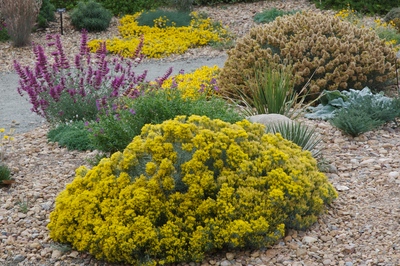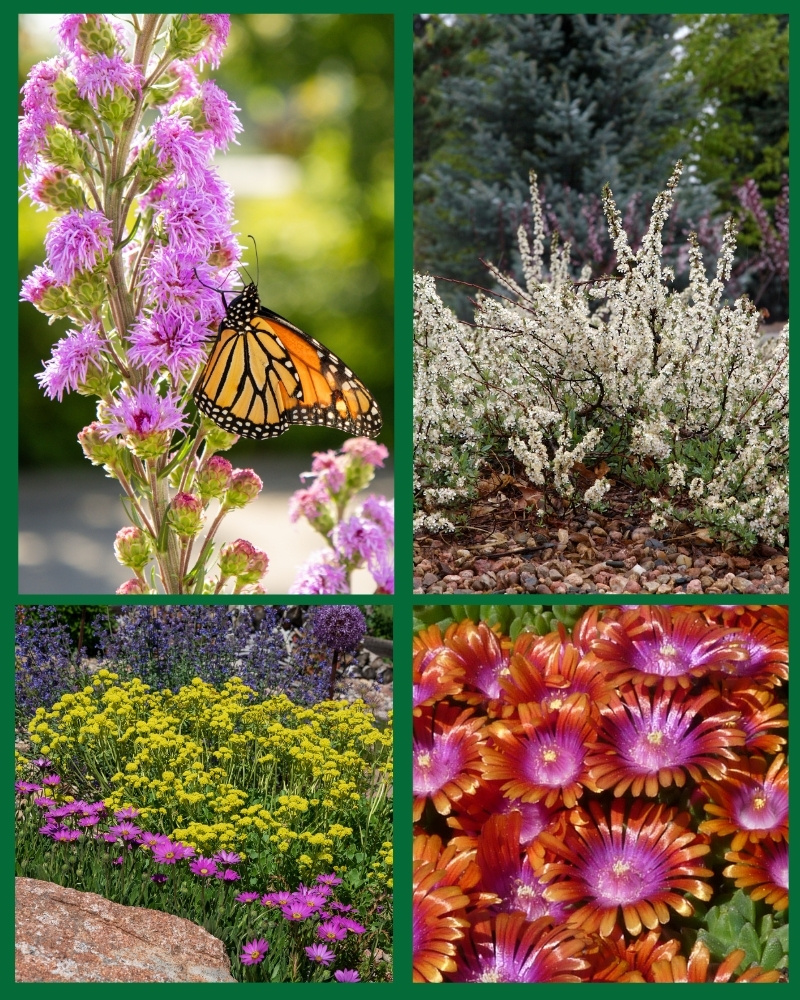Baby Blue rabbitbrush

When I was in high school in a student exchange program, Jen from Sydney, Australia came to Colorado in the fall. It wasn’t until we took a road trip down to the Royal Gorge area did she say, “This area looks exactly like a John Wayne movie. This is always how I imagined the American west to look.” She never said that about the suburbs of Denver. Have we gotten that far away from our regional “reality”?
With our bluegrass lawns and Maple and Honeylocust trees we have lost some of the reality of the American west. People from other parts of the world often have a clearer image of the American west than we who live here. Why do we so often alter it to look like somewhere else? Growing native plants that love the sun, tolerate the wind and cold as well as drought is a sensible way of reclaiming the natural beauty of our region.
Everything old is new again, from the remaking of ‘True Grit’ to Plant Select® “reintroducing” Baby Blue Rabbitbrush (Ericameria nauseosa var. nauseosa). This great native plant loves the sun, endures the wind and cold and is very drought tolerant. Baby Blue features needle-like, vivid blue leaves and is more compact than the larger growing rabbitbrush: Ericameria nauseosa.
Bright yellow flowers cover it in late summer and extend well into November. Butterflies love it. One year I had hundreds of Painted Lady Butterflies covering the blooms. I have a soaker hose snaking through the prairie grass for extra irrigation, but I did not need to include this plant in the loop! It is best to water as needed the first year to get your plant established. But once established, if it receives too much water it will likely need pruning to maintain a nice shape.
Group this plant with other outstanding natives such as Tall Western Sage (Artemisia tridentata) or Little Blue Stem (Schizachyrium scoparium), or even with ‘Blonde Ambition’ blue grama grass (Bouteloua gracilis ‘Blonde Ambition’). Add even more color with past Plant Select® great plains prairie selections like, Silver Blade Evening Primrose (Oenothera macrocarpa subsp. incana), Prairie Jewel Penstemon (Penstemon grandiflorus), and just for fun, you could add the aroma (not yet available through the movies) of chocolate with Chocolate Flower (Berlandiera lyrata). Imagine your American West – it’s easy when you plant a great native like Baby Blue rabbitbrush.
View the plant profile here. Or watch the video here.
Baby blue rabbitbrush (Ericameria nauseosa var. nauseosa)
Shrub
Height: 16-24 inches
Width: 20-30 inches
Blooms: Bright yellow blossoms, September-November
Sun: Full sun to partial shade
Soil Moisture: Dry to xeric (Little or no irrigation needed once established.)
Hardiness: USDA zones 4-9 (up to 8000’)
Culture: Clay, loam soils, or sandy soil
Thanks to Shalene Hiller, City of Westminster, for writing this piece.



Could you tell me more about the root system of this plant?
They are strong roots that are fairly fibrous. Not intrusive, but find and store water well. Might be a problem over the leach field if that is the question, but I have no experience with that.
how do you propgate rabbit brush? rabbit brush seeds
You can propagate rabbitbrush either way (seed or cuttings). However, if done by seed, the plant may have crossed with and the offspring my look different or be a different size than Baby Blue.
Hi Ross,
So does that mean Plant Select propagates this plant by cuttings or tissue culture essentially cloning this plant so that there is no longer any genetic diversity?
Our members propagate this plant by seed. Please know that most seed in the urban settings will not come true to form because there are so many other large green rabbitbrush in the area. Bees will cross-pollinate all nearby plants preventing the Baby Blue from coming true from seed.
Is dwarf blue rabbitbush the same as dwarf rubber rabbitbush? If different, how so?
The Plant Select dwarf rabbitbrush is a bluer selection otherwise another common name for all rabbitbrush is rubber rabbitbrush. Not sure why that is.
I’ve heard that the bark of this plant was used as a chewing gum by Native Americans. The milky sap contains rubbery compounds that were studied throughout the 20th century as a source of rubber, particularly during World War I and World War II. Recently there has been renewed interest in rubber rabbitbrush as a source of “hypoallergenic” rubber for people with latex allergies. (US Forest Service and other sources)
Interesting. That may be why the common name of rabbitbrush is also rubber rabbitbrush. I don’t think I’ll try chewing it though. Thanks!
My dwarf rabbitbrush is looking very dry and brownish. It’s in the sun all day long, on a drip system and has been in the same place for 7 years. Is it at the end of its life span or is there something I can do to revive it?
Rabbitbrush typically lives longer than that. Water that plant less often or plug up the emitters to reduce watering. Next spring trim it way back and it should return. Enjoy!
We have planted this plant in our demo garden and I also have it in my own garden in a totally unirrigated area. It does really well without water, but one problem is that it has reseeded itself in both locations vigorously. If it doesn’t come true to seed that might be a problem in the long run, especially in a garden setting. Maybe not so much in a wild area. Unless of course you are willing to pull many volunteers all spring which is what I have done. To keep its nice shape I’ve also had to trim it back in both locations early in the spring. It’s a great plant for very dry locations but know what you’re getting!
Where I can buy a baby blue rabbitbrush for my pollinator garden?
Here is a list of places- https://plantselect.org/where-to-buy/retailers/
I have looked for this plant for two years and have not found it locally. Is it available anywhere?
Have you checked the shrub sections of your local nurseries? While rabbitbrush is small and fills the space of a perennial, it is actually a shrub. The common names can very too. It can be called Baby Blue or Dwarf rabbitbrush. If the foliage is blue, it is the same plant. Check around again. Baby Blue rabbitbrush is a staple landscape plant sold at most garden centers on the Front Range of CO.
Will rabbit bush grow in containers? They would be in the sun almost all day in an entry way with not a lot of air circulation.
Yes, It sure will. Trim it annually and if it receives some supplimental water it’s blue foliage is very pleasant in a container.
My baby rabbit brush has outgrown the space the landscaper had for it. Can I divide it and transplant part of it? If so, when is the best time to do this?
This isn’t really a great plant to divide. Sometimes if a low branch laying on the ground begins to root out, you can transplant that cutting.